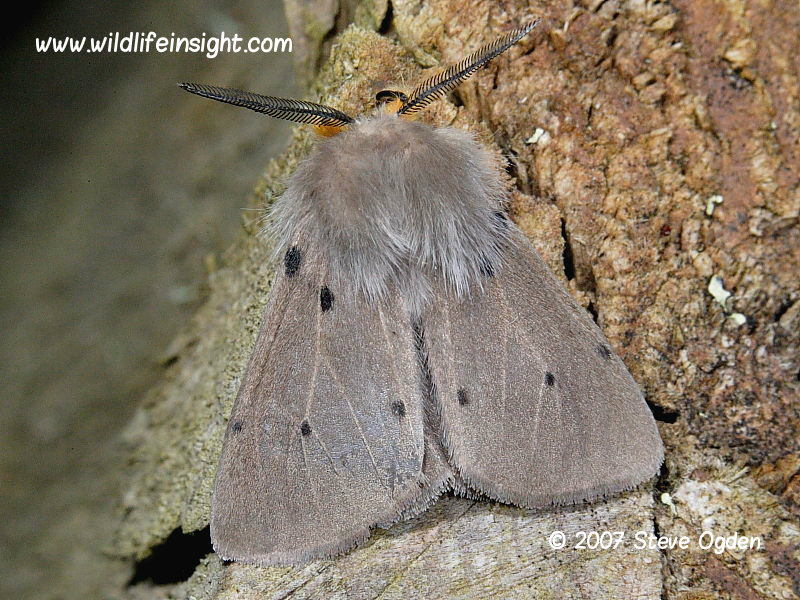The Muslin Moth -Diaphora mendica
The Muslin Moth is a common species throughout much of England and Wales, becoming scarcer and more localised further north into Scotland.
The moths fly in a single generation from late April to early June in a wide variety of habitats including gardens, along hedgerows, in open countryside and on the edge of woodlands.
Only the males are attracted to light.
Other similarly coloured common species are White Ermine, Buff Ermine, Yellow Tail and Brown Tail
Muslin Moths have a forewing length of between 14 and 19mm with females slightly larger than males.
Males predominantly have greyish brown forewings with a variable number of black spots.
Pale male Muslin Moths
The unusual creamy white male Muslin Moths featured were attracted to light in open woodland on the Cornish/Devon border
These were a similar colour to male Muslin Moths found in Ireland.
Females are white with variable numbers of irregularly spaced black spots. Unlike the males the females are more likely to be seen during the day either flying in sunshine or when disturbed from low growing vegetation.
The female Muslin Moth featured was recorded during the day beside a path on a South Devon cliff top.
Muslin Moth aberration
Aberrations or known forms of Muslin Moths appear to be few.
The male featured shows two faint white bands on the forewing and some larger than normal black spots on the underwing.
Muslin Moth caterpillar -Diaphora mendica
The fully grown Muslin Moth caterpillar is c 35 mm.
The body ground colour is grey with tufts of gingery/brown hair sprouting from warts.
The head is a dull orangey brown.
The eggs, other caterpillar instars and cocoon featured below were reared from eggs laid by a female found on the south coast of Cornwall.
Other hairy caterpillars such as Tiger Moth and Ermine moth caterpillars are featured in the hairy caterpillars page
Other caterpillars are featured in the moth caterpillars galleries and butterfly caterpillar galleries
Muslin Moth eggs
Between April and June females lay small batches of pale eggs on the leaves of the larval foodplant – a wide variety of low growing herbaceous plants.
In gardens many of the larval foodplants are considered weeds by gardeners such as dandelions, dock and plantain. Those featured were reared on dandelion.
Muslin Moth life cycle and caterpillar instars -Diaphora mendica
The eggs hatch in 10-20 days with the 2mm long caterpillars feeding on the eggs before dispersing.
The caterpillars feed most actively at night.
Identification requests – please see Help with identification for information that can help identify caterpillars.
Recommended caterpillar and moth reference books –
The Colour Identification Guide to Caterpillars of the British Isles – Jim Porter.
Field Guide to the Moths of Great Britain and Ireland – Waring, Townsend and Lewington.
Provisional Atlas of UK’s Larger moths – Randle, Fox and Parsons
Muslin Moth cocoon
The caterpillars are fully grown after 30-40 days with most ready to pupate by mid September
When wandering in search of a pupation site they are capable of surprising speed.
The Muslin Moth cocoon is spun amongst plant litter.
The cocoons overwinter with the earliest moths emerging in April.
